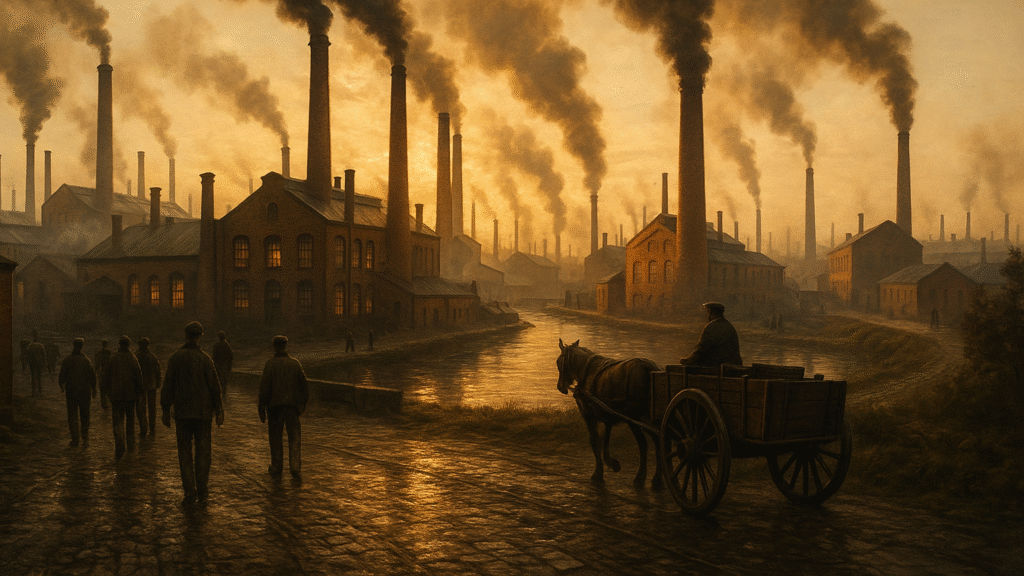The industrial revolution changed our world, we see the changes around us — this is due to this revolution, it is not about any new machine, but it changed how we lived, worked, and everything.
The big change started in the late 1700s in Great Britain, and then it reached the other countries.
Let’s see how this revolution helps the world where we live today.

The Beginning of Modern Industry
Before the Industrial Revolution, most people worked on farms or made things by hand. Life was slower, and products were made one by one. Things started to change when machines like the spinning jenny and steam engine were invented. These machines helped make products much faster and in bigger amounts.
James Watt made the steam engine better in the 1760s, which was very important. Factories began to appear in cities, and people moved from farms to work in them. This started the factory system, which changed things from making products by hand to making them with machines. (Source: Encyclopedia Britannica)
A New Economy Emerges
When production speeds up, the impact is that the business grows rapidly. This gives another opportunity, i.e., the goods are allowed to be sold in other countries instead of just focusing on local sales.
Countries like Britain and then the U.S. become bigger markets due to their factories.
With all these changes, banking and investing become more common.
Please note that it was those who had money who thought, and started factories, new inventions, etc.
While this built more opportunities for some, it also made the difference between rich and poor even bigger.
Big Social Changes
People started moving to cities to bringbig changes. The cities are starting to become crowded, and life isn’t always easy — Now this leads to the rise of a new middle class where people are working as managers, clerks, shopkeepers, etc.
With time, education became more important, and people needed to know how to read and write to be hired for different types of jobs.
Governments started building public schools, and workers rights began to improve.
For demanding better wages and safer working conditions, the labor unions also formed.
Transforming Transportation and Communication
The Industrial Revolution not only upto factories but it changed how people moved and communicated.
The Steam-powered trains and ships allowing the goods to transport faster and farther, the people are also travel faster and farther.
The telegraph was invented which makes easy to send messages quickly.
With the invention of these the world started to looks smaller. If a product made in England that can be sold in India. If a message sent from New York cound reach london in minutes. This laid the groundwork for globalization
The Global Impact
With time, the Industrial Revolution began to spread to Europe, North America, and later to Asia.
Based on the resources and political systems of each country, they began to adapt this revolution in their own way.
However, there was an impact of this – industrialization helped colonization. European powers started to take control of less developed places using their advanced technologies, they often used their people and exploited their resources.
As different countries started to grow stronger because of the industries, it led to competition between them.
This, in turn, led to a new issue – a nation’s power was starting to be judged by how advanced its industry was. These developments started to shape the economy and international relations between countries, and also influenced wars.
Environmental and Labor Effects

Not everything that changed was for the better. With more factories came more pollution. Rivers got filled with waste, and the air became hard to breathe because of all the smoke from burning coal. Factory workers had to deal with long, tough hours, and sadly, even kids were made to work in unsafe places.
Because of these problems, people started speaking up. They wanted cleaner air, safer jobs, and better places to live. This was the beginning of some of the first movements to improve the environment and protect workers. Many of the labor laws we follow today started during this time.
A Revolution That Lives On
Machines weren’t the most powerful invention of the Industrial Revolution, its influence fell in every aspect of people’s life every day. They moved to cities and worked in factories instead of on farms. Time sped up and people began to see work, progress and inventions in a new light. Well, countries traded more, and new ways of doing business came up.
We continue to see the effects to this day. That was when things like work being done by robots, mass production and using computers all began. The way we live, and work, and do business today must have begun back then.
Understanding how it all started gives us insight into the world we currently inhabit — and teaches us to approach new ideas wisely and cautiously.
